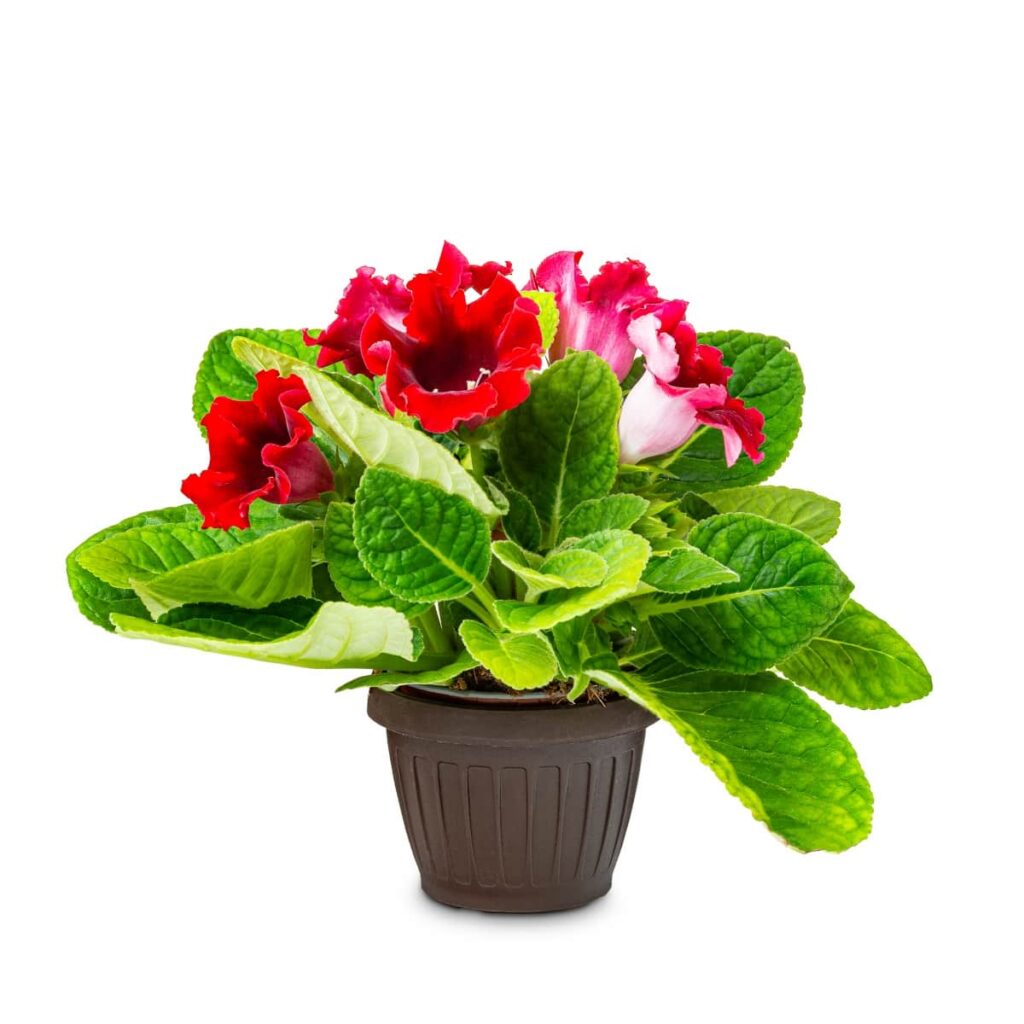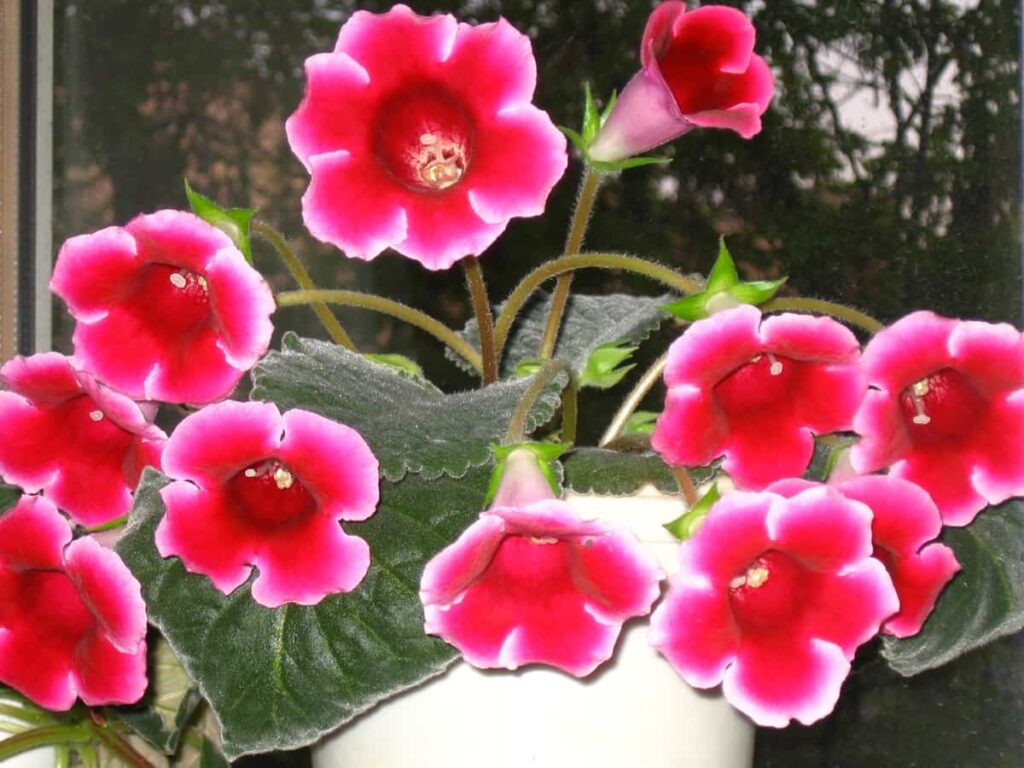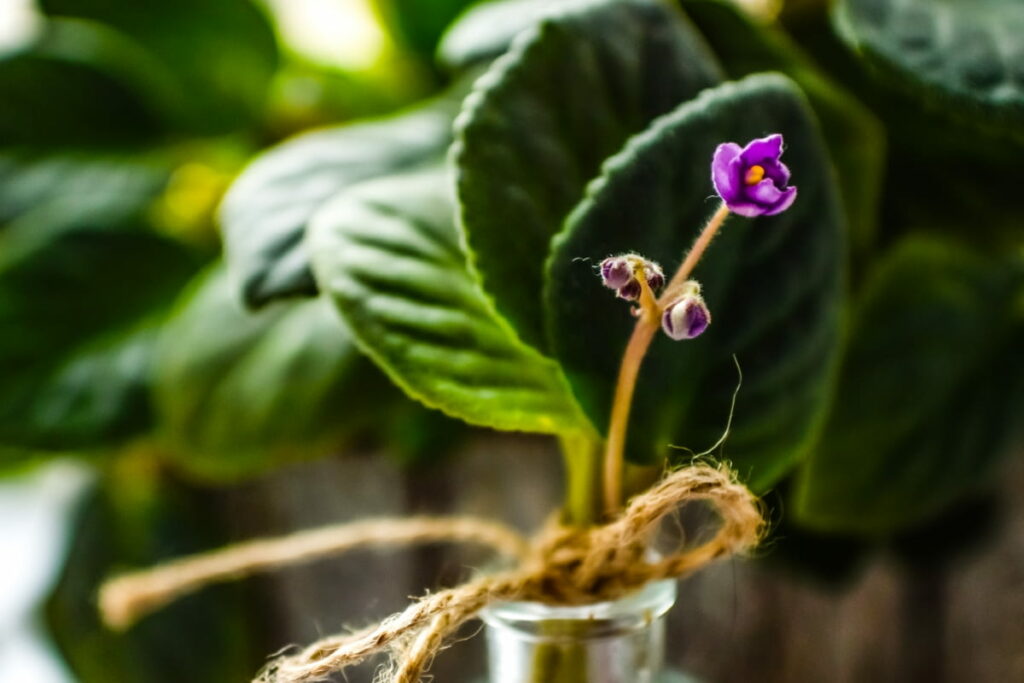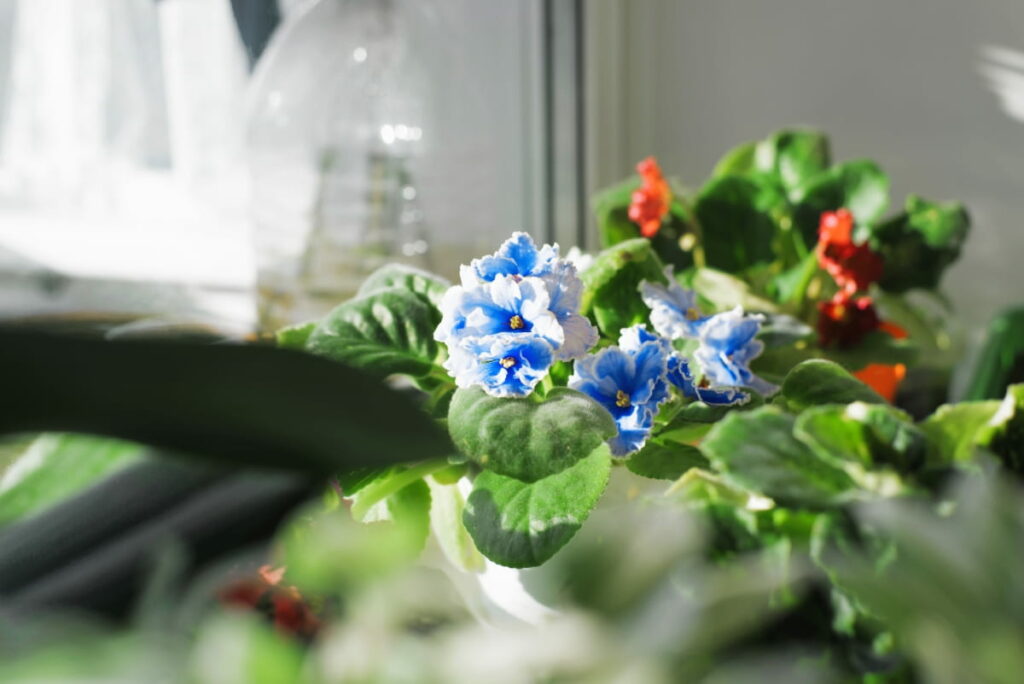Gloxinia, scientifically known as Sinningia speciosa, is a perennial flowering plant that belongs to the Gesneriaceae family. With its vibrant and showy flowers, Gloxinia adds a touch of elegance and color to any indoor space. These stunning flowering plants are easy to care for, making them the perfect choice for experienced gardeners and beginners.

Growing Gloxinia Houseplants
Choosing the Right Gloxinia Variety for Your Home
Choosing the right variety of Gloxinia for your home is an important step in ensuring successful growth and beautiful blooms. One option to consider is the Gloxinia speciosa ‘Brocade Double Mixed’ (F1 Hybrid). The fully double-flowers come in a range of colors, adding a vibrant touch to any place.
Another variety is Sinningia speciosa ‘Corina.’ If you’re looking for something with unique floral characteristics, Sinningia speciosa ‘Hollywood’ might be the perfect choice. It showcases lilac-purple flowers with a white throat, creating an eye-catching display. Also, Sinningia speciosa ‘Violacea’ offers velvety textured flowers in shades of dark purple or violet with ruffled petals that add an elegant touch.
Soil and Potting Mix
Choose a well-draining blend that retains moisture but doesn’t become waterlogged. A mixture of perlite, peat moss, and vermiculite works well as it provides good drainage while holding onto enough moisture to keep the plant hydrated. To further improve the soil’s texture and nutrient content, you can add organic matter. This will help promote plant healthy development and overall plant vigor. It’s important to note that Gloxinias prefers slightly acidic soil with a pH level around 6.0-6.5.
Lighting Needs and Care
These stunning plants thrive in bright but indirect light, making them well-suited for indoor spaces. Place your Gloxinia plant near a window that receives filtered sunlight throughout the day. Avoid exposing plants to direct sunlight, as this can scorch their delicate leaves. If you don’t have access to enough natural light, you can supplement with artificial lighting. Use fluorescent or LED grow lights specifically designed for houseplants. Position the lights 6-12 inches above the plants and keep them on for 12-14 hours a day.
Planting and Transplanting
Select a pot or container for growing Gloxinia that has good drainage holes. Next, prepare the soil mix for your Gloxinia. A well-draining mixture of peat moss, perlite, and vermiculite is ideal. Now it’s time to remove your Gloxinia from its current container or tray carefully. Gently loosen the plant roots with your fingers or a small tool, being careful not to damage them.
In case you missed it: How to Grow Brahma Kamal Flower in the Home Garden: Guide for Growing in Pots and Ground

Place the plant into its new pot at the same depth as it was previously planted. Fill in any gaps with soil mix and lightly pat it down. After planting, give your Gloxinia a thorough watering until water drains out of the bottom of the pot. If you’re transplanting an established Gloxinia into a larger pot, handle it with care so as not to disturb its root system too much. It’s best to do this when the plant is dormant during winter or early spring.
Propagation and Repotting
The main method for growing Gloxinia is the ability to propagate new plants from existing plants. There are a few different methods you can try, but one of the easiest is leaf cuttings. Take a healthy leaf from your plant and locate it in a pot filled with moist potting soil. Keep it warm and humid, and before long, you’ll see tiny new plants emerging from the base of the leaf.
When it comes to repotting your Gloxinia, timing is key. Wait until after flowering has finished before attempting to move your plant to a larger pot. Carefully remove it from its current container, being careful not to damage the delicate roots. Please place it in its new home with a good potting mix, making sure not to bury the stem too deeply. Remember that proper care during propagation and repotting is essential for success.
Watering and Fertilizing
These beautiful flowering houseplants require consistent moisture to grow, but it’s important not to overwater them. When watering your Gloxinia plants, ensure that the soil is evenly moist without becoming waterlogged. It’s better to underwater than overwater your Gloxinia, as they prefer slightly drier conditions.
Use a liquid fertilizer specifically formulated for flowering plants. Apply the fertilizer diluted with water every two weeks during the growing season. This will provide essential plant nutrients for healthy growth and vibrant blooms. Always follow the instructions on the label and adjust accordingly based on your specific plant’s needs.
Temperature and Humidity
To ensure the health and vitality of your Gloxinia plant, it’s important to provide them with the right environment. Gloxinias prefer a range between 18°C and 24°C. They don’t tolerate extreme cold or heat well, so try to keep them away from drafts or direct sunlight that can cause temperature fluctuations.
In terms of humidity, these plants love moisture. Choose for a relative humidity level of around 50% to 60%. If you live in a dry climate or during winter when indoor heating dries out the air, use a humidifier or place your Gloxinia on a tray filled with pebbles and water. This will help increase the surrounding moisture levels. Another way to maintain adequate humidity is by misting the leaves regularly. Use room-temperature water to prevent shocking your plant with cold water droplets.
Pest and Disease Control
These beautiful houseplants can be affected by a variety of pests like aphids, mealybugs, and spider mites. To prevent infestations, it’s important to regularly inspect your plants for any signs of these pesky critters. If you notice tiny white specks or sticky residue on the plant leaves, it could be a sign of aphids or mealybugs. These insects can quickly multiply and cause damage to the Gloxinia plant by sucking out its sap.
To combat them, you can try using natural remedies like neem oil or insecticidal soap. These products are safe for the Gloxinia plant and will help eliminate the pest problem. Another common pest that can affect Gloxinia plants is Spider mites. They are tiny pests that feed on the plant’s sap and create fine webbing on the leaves. They can cause major damage to the foliage. To control spider mites, regular misting with water or using a mild insecticidal soap solution can help keep their population in check.
In case you missed it: Dutch Rose Farming Business in India: Economics, Cost, and Profit for 1 Acre Cultivation

Gloxinia plants are also susceptible to diseases such as powdery mildew and botrytis blight. Powdery mildew disease appears as a white color powdery substance on the leaves, while botrytis blight causes brown spots and rotting of flowers and stems. Good air circulation around the Gloxinia plant and avoiding overwatering the plant can help prevent these diseases from taking hold.
Pruning and Training
Pruning helps maintain their shape, promotes healthier growth, and encourages more abundant blooms. As your Gloxinia plant grows, it may develop leggy or straggly stems that can detract from its overall appearance. To combat this, use clean and sharp scissors to trim back any overgrown or dead foliage. You can use stakes or trellises to provide support for the plant as it grows taller. This will help prevent the stems from flopping over and ensure that the flowers are displayed beautifully.
Another method of training is pinching back the tips of the main stem or side shoots to encourage bushier growth. By doing this regularly during the growing season, you’ll promote more branching and increase flower production. Remember always to be gentle when pruning or training your Gloxinia plants, as they can be delicate. Take your time and observe how each plant responds to different techniques.
Frequently Asked Questions (FAQ) on Growing Gloxinia Plants
Do Gloxinias Require Any Special Care During Dormancy?
During their dormant period (usually winter), reduce watering and allow them to rest in a cool location with lower light levels. Resume regular care once new growth appears in spring.
Can I Grow Gloxinia from Seeds?
Yes, you can grow Gloxinia from seeds, but it requires patience and skill. It’s often easier to start with a young plant from a nursery or propagate them through leaf cuttings.
Can I Grow Gloxinias Outdoors?
Gloxinias are typically grown as houseplants; they can be moved outdoors during warmer months if you live in a suitable climate. Just make sure they receive bright indirect light and are protected from strong winds.
In case you missed it: How to Grow Desert Roses: Varieties, Soil, Planting, Pruning, Fertilizers, and Care

Conclusion
Gloxinias have gained popularity worldwide for their striking blooms. They are relatively small plants with dark green foliage that perfectly complements the vibrant hues of their flowers. These Gloxinia plants can be grown in pots or hanging baskets, making them versatile options for decorating your home. Gloxinia is a beautiful perennial flowering plant that can bring color to any indoor space.
- Crops Grown in Summer Season: Best Choices for Summer Gardening
- Organic Pest Control for Tomato Farming
- How to Maximize Sheep Farming Profit
- Broccoli Varieties: Choosing the Right Cultivars for Your Farm
- How to Raise Pigs in Your Own Backyard: A Comprehensive Guide
- Budget Friendly Sheep Shed Ideas: Cheap and Low-Cost Tips
- How Much Do Cattle Farmers Make: Revenue Streams in Cattle Farming
- Management Pests and Diseases in Your Cotton Field
- Sheep Farming Business Plan for Beginners
